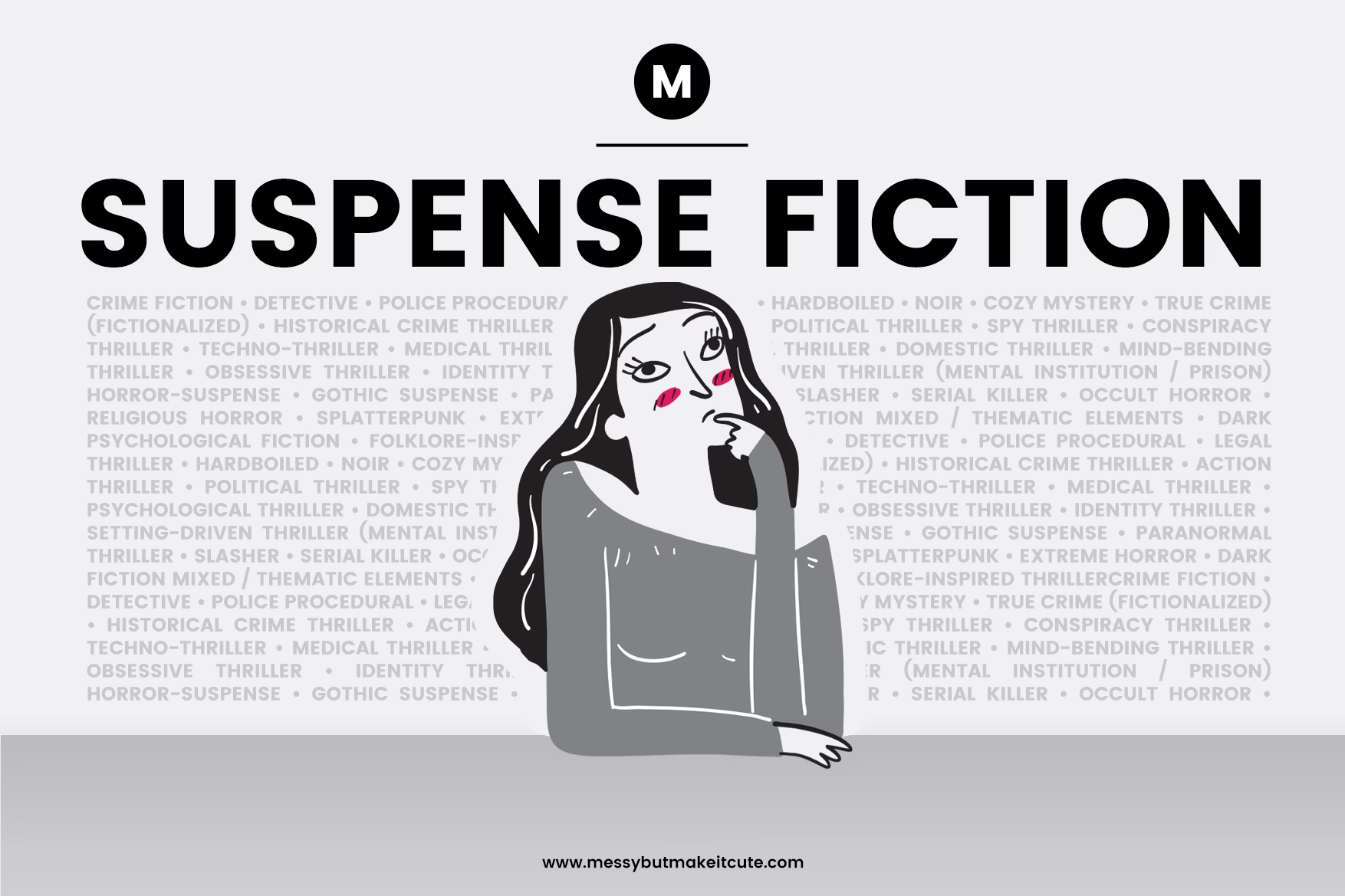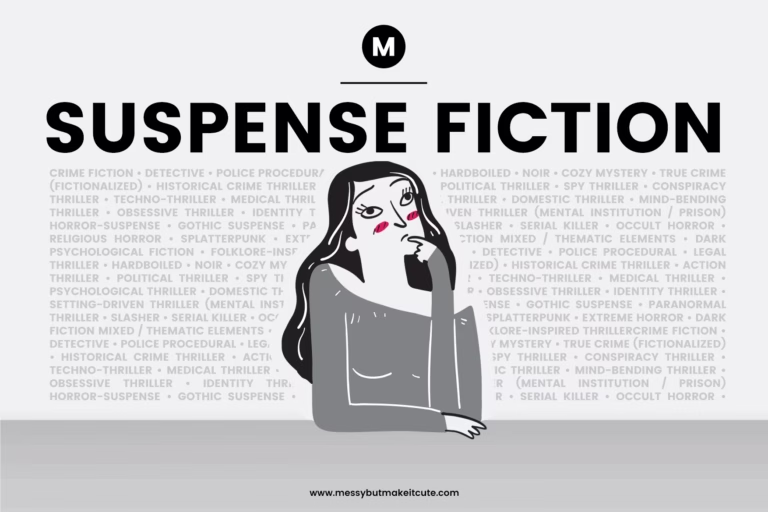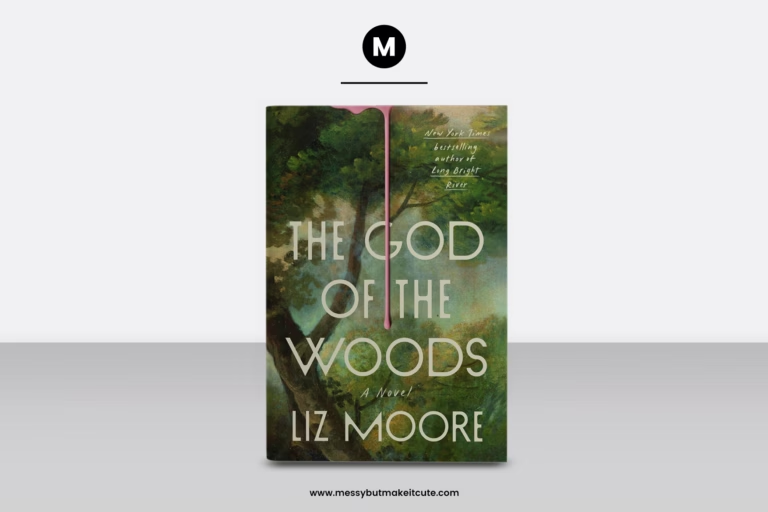
What is a TBR list?
What does ARC mean?
What does DNF mean in a book review?
were turning my brain into a mystery novel of its own!!
So, to make things easier, I did some research and put together a humble mini-dictionary of the most common terms you’ll come across when starting your suspense fiction journey. I also included a few key literary terms that are helpful to know. Everything is organized in alphabetical order, so whenever you feel unsure, you can come back here and quickly check what those words really mean.
Plot and Structure Terms
These are the words that describe how a story is built. They explain the techniques authors use to create tension, twists, and flow in suspense fiction.
|
Term |
Definition and Examples |
|---|---|
|
Beat |
A small, significant event that advances the plot, often marking a shift in tension. |
|
Chekhov’s Gun |
A storytelling rule that says if an author shows an important detail early, it must come back later in the story. In suspense fiction, this could be a small clue, an object, or even a line of dialogue that seems unimportant at first but becomes vital in solving the mystery. |
|
Cliffhanger |
An ending to a chapter or section that leaves the story unresolved, building anticipation. |
|
Climax |
The peak of tension where the main conflict reaches its height. |
|
Dark Night of the Soul |
The protagonist’s lowest emotional point, often near the end of the second act, heightening despair before resolution. |
|
Denouement/Resolution |
The wrapping up of loose ends after the climax, providing closure. |
|
Deus Ex Machina |
An unexpected, contrived resolution that solves the plot without logical buildup. Often criticized in suspense for feeling like a cheat. |
|
Exposition |
Background information delivered to set the stage, often subtly in suspense to avoid info-dumps. |
|
Fair Play |
A mystery where all clues are presented to the reader, allowing them to solve it alongside the detective. Common in Golden Age whodunits like those by Agatha Christie. |
|
Hook |
The opening element that grabs attention immediately. |
|
Inciting Incident |
The event that kickstarts the main plot. |
|
Linear vs. Nonlinear Narrative |
Whether the story unfolds in order or jumps around in time. Nonlinear Narrative – The story jumps around in time, mixing past and present. Example: A thriller that opens with the murder, then flashes back to the weeks before, and later returns to the investigation. |
|
Midpoint |
A major reversal or revelation halfway through, escalating stakes. |
|
Multiple POV (Point of View) |
When a story is told through the eyes of more than one character. This technique lets readers see different sides of the mystery and often creates dramatic irony, since you know things one character doesn’t. |
|
Plot |
The sequence of events driving the story forward. In suspense, it’s often layered with twists. |
|
Plot Twist |
An unexpected change in direction that alters the reader’s understanding. Example: The big reveal in Fight Club by Chuck Palahniuk. |
|
Rising Action |
The series of events building toward the climax, increasing tension. |
|
Subplot |
A secondary storyline that intersects with the main plot, adding depth. |
Character and Development Terms
These terms focus on the people who drive the story. They explain how authors build personalities, reveal motives, and shape characters in ways that keep readers guessing and turning the pages.
|
Term |
Definition and Examples |
|---|---|
|
Antagonist |
The opposing force or villain creating conflict. |
|
Character Arc |
The transformation or growth a character undergoes. |
|
Dynamic Character |
A character who changes significantly due to events. |
|
Flat Character |
A character with little depth or complexity, often serving a specific role without significant development. |
|
Foil |
A character contrasting another to highlight traits. |
|
Ghost/Wound |
A past trauma influencing current actions, common in thrillers. |
|
Morally Grey |
A character who operates with ambiguous ethics, neither fully good nor evil, adding depth to suspense narratives. |
|
Motivation |
The reason behind a character’s goals, revealed gradually. |
|
Protagonist |
The main character driving the story, facing conflict. |
|
Round Character |
A multifaceted character with depth and contradictions. |
|
Static Character |
A character who doesn’t change, often a steadfast villain. |
|
Underdeveloped Character |
A character lacking sufficient depth, background, or growth, often criticized in reviews for feeling incomplete. |
|
Unreliable Narrator |
A storyteller whose account can’t be trusted, building doubt. |
Literary Devices for Building Tension Terms
These are the tools writers use to keep you on edge. From subtle hints to shocking twists, they shape the mood, create suspense, and make you feel the tension rising with every page.
|
Term |
Definition and Examples |
|---|---|
|
Dramatic Irony |
The audience knows more than the characters, creating dread. |
|
Far-fetched |
Far-fetched refers to a plot point, twist, or scenario that feels implausible or unlikely, stretching believability but sometimes used for dramatic effect in suspense fiction. |
|
Flashback |
A scene from the past interrupting the present, revealing clues. |
|
Foreshadowing |
Subtle hints at future events. |
|
Info-dump |
A large amount of background information delivered at once, often disrupting the pacing of a suspense story if not handled carefully. |
|
In Medias Res |
Starting the story in the middle of action. |
|
MacGuffin |
An object driving the plot but ultimately unimportant. |
|
Misdirection |
Deliberately leading the reader astray. |
|
Motif |
A recurring symbol or idea reinforcing themes, like shadows in noir. |
|
Pacing |
The speed at which the story unfolds, often quick in thrillers to maintain urgency. |
|
Red Herring |
A false clue misleading the reader or characters. |
|
Suspension of disbelief |
Suspension of disbelief is the reader’s willingness to overlook implausible or unrealistic elements in a story to stay immersed in the narrative. |
|
Tension |
The emotional strain from uncertainty or danger. |
|
Trope |
A common, recognizable convention or cliché. |
Book Review and Community Terms
These are the expressions you’ll often see in reviews, online book clubs, and the wider bookish community. They cover how readers share opinions, rate books, and connect with others who love suspense fiction just as much as they do.
|
Terms |
Definition and Examples |
|---|---|
|
ARC (Advanced Reader Copy) |
An early version of a book given to reviewers before official release. |
|
Binge-Read |
Reading multiple books in a series back-to-back, common for addictive thriller series like Stieg Larsson’s Millennium trilogy. |
|
Book Hangover |
The lingering emotional impact of a book that leaves you reeling, often making it difficult to start a new read immediately. |
|
BOTM (Book of the Month) |
A subscription service pick, often highlighted in reviews for popular suspense titles. |
|
MC/FMC/MMC |
Abbreviations for Main Character, Female Main Character, and Male Main Character, used to identify key figures in a story, often discussed in reviews for their roles in driving suspense. |
|
Cliffy |
Slang for cliffhanger, used in reviews to warn about unresolved endings. |
|
CR (Currently Reading) |
The book you’re in the middle of. |
|
DNF (Did Not Finish) |
When a reader abandons a book midway, often cited in Goodreads reviews for slow-paced thrillers. |
|
HEA (Happily Ever After) |
A satisfying, positive ending—rarer in dark suspense but appreciated in lighter mysteries. |
|
HFN (Happy For Now) |
HFN (Happy For Now) |
|
Mood Reader/Free-Range Reader |
A reader who selects books based on their current emotions or spontaneous interests, rather than a planned schedule. |
|
POV (Point of View) |
The perspective from which the story is told, like first-person in unreliable narrator thrillers. |
|
Reading Slump |
A lack of enthusiasm for reading, often triggered by a series of disappointing suspense novels. |
|
RTC (Review To Come) |
Placeholder in Goodreads updates meaning a full review is pending. |
|
Spoiler |
Information in a review or discussion that reveals key plot details or twists, potentially ruining the suspense for other readers. |
|
TBR (To Be Read) |
Your stack of unread books, often overflowing with suspense recommendations. |
Format/Publishing Terms
These are the words connected to how books are released and consumed. They cover everything from editions and formats to industry terms that often pop up in reviews, author notes, and publishing news.
|
Terms |
Definition and Examples |
|---|---|
|
Backlist |
Titles published before the current year, often rediscovered by fans of suspense series. Example: “I found a backlist whodunit by Agatha Christie at a local bookstore.” |
|
Finished Copy/FC |
The completed, polished version of a book as sold to the public. |
|
HC |
A hardcover book, known for durability and often preferred by collectors of suspense fiction. |
|
Indie/Small-Press |
A book published by a small, independent publisher, often offering unique suspense stories. |
|
ISBN |
A unique identifier for a published book, used for cataloging and ordering. |
|
Mass Market Paperback |
A smaller, cheaper paperback designed for wide distribution, common for suspense and thriller bestsellers. |
|
MS |
The manuscript, the author’s original draft of a book before editing or publication. Example: “The author teased their MS for a new suspense novel on social media.” |
|
New Release |
A book published recently, often within the current year, generating excitement among suspense readers. |
|
OOP |
Out of print, meaning a book is no longer published, requiring readers to seek secondhand copies. |
|
PB |
A paperback book, typically more affordable and portable than a hardcover. Example: I grabbed the PB of a classic noir for an easy reread. |
|
Physical Copy |
A printed book, either hardcover or paperback, as opposed to a digital version, often valued by suspense fans for ARCs or collectibles. |
|
Pre-order |
Incentive/Campaign Special perks offered to readers who order a book before its release, exciting suspense fans. |
|
Self-Published |
A book released directly by the author, often through platforms like Amazon, common in niche suspense genres. |
|
Trade Paperback |
A larger, higher-quality paperback, often used for literary or mainstream suspense novels. |
|
Traditionally Published |
A book released by a major publishing house, typical for bestselling suspense authors. |
|
WIP |
A work in progress, a book currently being written by the author. |
A Beginner’s Guide to Suspense Fiction (Series)
What Do You Think? Let’s Talk Bookish Terms!
Which of these terms were already familiar to you, and which ones were totally new?
Share your thoughts in the comments, I’d love to know what surprised you the most!


